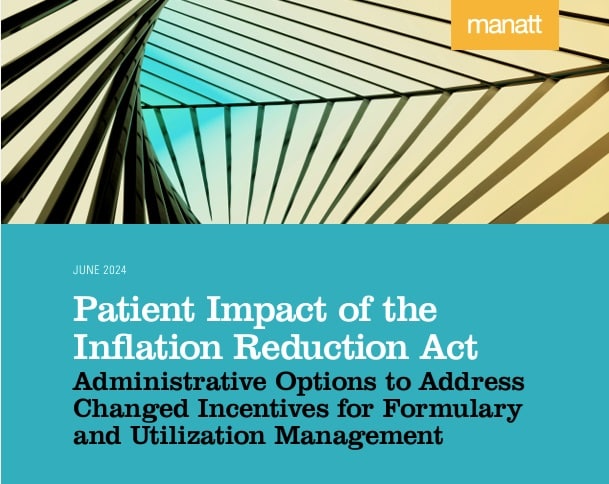Report: Medicare System Can Do More to Protect Beneficiaries
Published June 27, 2024
Utilization management practices such as step therapy and prior authorization could limit access to lower prescription drug prices and a cap on out-of-pocket costs at the pharmacy
Washington, D.C. – While the Inflation Reduction Act (IRA) makes significant changes to the Medicare Part D prescription drug benefit and directs the Centers for Medicare and Medicaid Services (CMS) to impose government-negotiated prices for the drugs with the most Medicare spending, a new report details how some of the potential benefits may be unrealized absent action by CMS. If the agency does not place guardrails on insurers and contracted pharmacy benefit managers, beneficiaries may experience reduced access and lower-than-expected savings from the Medicare Drug Price Negotiation Program.
“For many older adults, interruptions or excessive delays in access to their medications are not just an inconvenience—they can threaten health and independence,” said Adina Lasser, Public Policy Manager at the Alliance for Aging Research. “We encourage the Medicare program to use its existing authorities, which are clearly outlined in this report, to better protect the beneficiaries they serve.”
According to the report from Manatt Health, sponsored by the Alliance for Aging Research, Medicare Part D prescription drug plan (PDP) sponsors face heightened costs as they bear more financial risk under the IRA’s benefit changes, and they will lose manufacturer rebate revenue when CMS negotiates the prices of drugs selected for negotiation. These factors may prompt plans to protect their financial margins by limiting access to drugs through narrower formularies, adopting more rigorous utilization management strategies like prior authorization or step therapy that will delay or deny access to therapy, or promoting drugs other than those CMS has selected for negotiation so as to protect their rebate revenue.
As part of IRA implementation and in advance of calendar year 2025, during which many changes to the design of the Part D benefit take effect, CMS could take steps to protect beneficiaries by preserving access and increasing transparency. CMS has already warned PDP sponsors not to place drugs selected for negotiation on non-preferred formulary tiers without clinical justification. But it can do more under its current legal authority, including:
- Require that drugs selected for negotiation—for which CMS has established a maximum fair price—be given preferred formulary status, without utilization management.
- Adopt a public “watchlist” for specific adverse formulary decisions that CMS will not approve, to keep PDP sponsors from excessive narrowing of formularies.
- Commit additional resources to formulary reviews so as to identify access issues before such issues can harm beneficiaries.
- Explicitly and publicly identify more situations where plans must cover more than two drugs per category or class to ensure that formularies provide adequate coverage of drugs commonly used by beneficiaries.
- Improve plan transparency so beneficiaries can more easily see when drugs have utilization management restrictions.
- Enforce minimum payment rates to pharmacies, to prevent sponsors from diverting patients away from community pharmacies.
- Actively monitor appeals, grievances and exception requests filed by beneficiaries with their plans, to have near real-time view of access issues.
- Improve appeals and grievance processes to reduce the burden of challenging a plan’s coverage decision.
- Adopt new actuarial equivalence tests to more accurately and quantitatively track whether plan sponsors are offering sufficient coverage of drugs selected for negotiation.
This paper discusses in detail the coming changes to Part D, some of the risks faced by beneficiaries as a result of plan sponsors changing behaviors in response to the IRA, the initial measures taken by CMS to date to protect beneficiaries, and steps CMS could take under its current legal authority to better protect timely beneficiary access to therapy.
“We hope that this paper serves as a useful roadmap for policymakers and a tool for patient advocates,” Lasser continued. “Implementation of the recommendations outlined in this paper would make a world of difference to older adults and all Medicare beneficiaries who depend on timely and affordable access to their medications.”
About the Alliance for Aging Research
Since 1986, the Alliance for Aging Research has served as a trusted source of health information for both consumers and health care professionals on diseases and conditions that disproportionately affect older adults and has led numerous successful advocacy campaigns promoting the health and independence of older adults. The Alliance is dedicated to changing the narrative to achieve healthy aging and equitable access to care. We strive for a culture that embraces healthy aging as a greater good and values science and investments to advance dignity, independence, and equity. Learn more about the Alliance at www.agingresearch.org.
##
To interview someone from the Alliance for Aging Research Health, email Katie Riley, Vice President of Communications, at [email protected].

